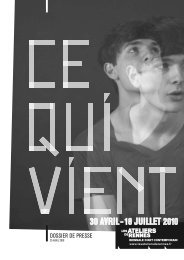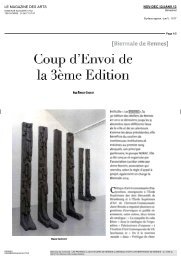Download here the Visitor's guide. - Les Ateliers de Rennes
Download here the Visitor's guide. - Les Ateliers de Rennes
Download here the Visitor's guide. - Les Ateliers de Rennes
You also want an ePaper? Increase the reach of your titles
YUMPU automatically turns print PDFs into web optimized ePapers that Google loves.
42<br />
<strong>Les</strong> Prairies's artists<br />
LUIS CAMNITZER<br />
Two Parallel Lines, 1976. Collection 49 Nord 6 Est – Frac Lorraine, Metz.<br />
Photography : Frac Lorraine.<br />
DUNCAN CAMPBELL<br />
Duncan Campbell maintains that documentary is<br />
a fictional form and he interrogates <strong>the</strong> nature of<br />
it in works in which archives and old images are<br />
reformulated within narratives to show how much of<br />
what <strong>the</strong>y contain is imagined. One of Campbell's<br />
specialities is portraits of emblematic characters from<br />
20th century history. Make it new John (2009) is <strong>the</strong><br />
story of John DeLorean and his invention, <strong>the</strong> DeLorean<br />
DMC-12, a sports car. DeLorean was a talented engineer<br />
and a vice-presi<strong>de</strong>nt of General Motors, which he left<br />
in 1973 in or<strong>de</strong>r to start his own company. He received<br />
subsidies from <strong>the</strong> British government to build a factory<br />
at Dunmurry in <strong>the</strong> suburbs of Belfast. Being located<br />
on <strong>the</strong> front line between Catholics and Protestants, it<br />
was hoped that <strong>the</strong> factory would help reduce social<br />
and political conflict by providing work for members<br />
of both communities. But <strong>the</strong> DeLorean was not much<br />
of a success and, almost immediately, John DeLorean<br />
ran into financial problems. The factory, which had<br />
a workforce of two thousand, closed in 1982, having<br />
produced no more than nine thousand cars. Ironically<br />
enough, <strong>the</strong> car became a symbol of <strong>the</strong> American myth<br />
and achieved iconic status in <strong>the</strong> film trilogy Back to<br />
<strong>the</strong> Future.<br />
M. C. tr. J.H.<br />
Born in 1972 in Dublin (Ireland), lives and works in<br />
Glasgow (Scotland).<br />
Two horizontal, parallel lines on a wall. These poetic<br />
cum philosophical fragments, which are both footnotes<br />
and <strong>the</strong> formalization of i<strong>de</strong>as at work, evoke by turn<br />
<strong>the</strong> horizon, a frontier, exclusion, a trajectory and also<br />
flatness and <strong>de</strong>ath. Two lines, parallel in space but also<br />
in <strong>the</strong>ir essence, lines that will never meet – words and<br />
things. An irreducible distance between <strong>the</strong> visual and<br />
<strong>the</strong> discursive, between <strong>the</strong> artwork and discourse about<br />
it. This hybrid piece reflects all <strong>the</strong> singularity of <strong>the</strong><br />
Uruguayan born, US immigrant artist, Luis Camnitzer.<br />
T<strong>here</strong> is a fundamental tension between <strong>the</strong> poetic and<br />
<strong>the</strong> conceptual. And yet, this piece is not fol<strong>de</strong>d in on itself<br />
with purely artistic concerns; it is far more open to <strong>the</strong><br />
world at large. Beyond its subtle interrogation of matters<br />
of representation, t<strong>here</strong> are, as always with Camnitzer,<br />
hid<strong>de</strong>n and profound signs to be unear<strong>the</strong>d about <strong>the</strong><br />
links between art and politics. The work displays certain<br />
clan<strong>de</strong>stine, autobiographical motifs such as frontiers,<br />
cross-cultures, and imprisonment. The straight line is by<br />
nature an inevitable separation, a shape from which t<strong>here</strong><br />
is no escape. The work has particular resonance in <strong>the</strong> life<br />
of this artist who has long been an exile against his will<br />
in <strong>the</strong> United States, and someone very affected by <strong>the</strong><br />
dictatorships of <strong>the</strong> 1970s.<br />
tr. J.H.<br />
Born in 1939 in Lübeck (Germany), lives and works in<br />
New-York (United States).<br />
Make it new John, 2009. Courtesy of <strong>the</strong> artist.<br />
Photography : Seamus Harahan.






